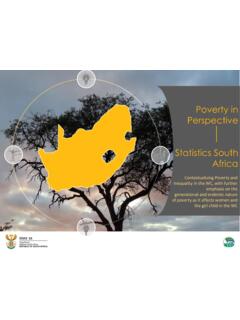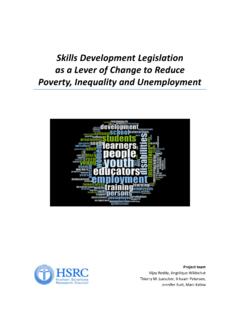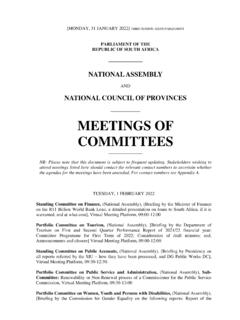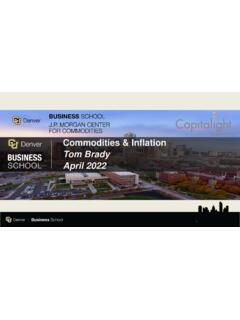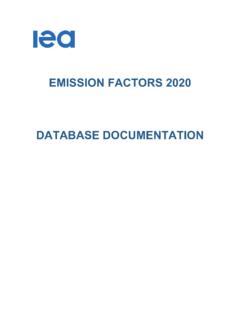Transcription of Analysis of Eskom’s financial position Full report
1 1. Analysis of Eskom's financial position Full report March 2017. The Parliamentary Budget Office (PBO) has been established in terms of the Money Bills Amendment Procedure and Related Matters Act, 2009 (Act no. 9 of 2009). The PBO provides independent, objective and professional advice and Analysis to Parliament on matters related to the budget and other money bills. The PBO. supports the implementation of the Act by undertaking research and Analysis for the finance and appropriations committees. This report has been compiled in response to a request from the Chairperson of the Standing Committee on Appropriations in Parliament.
2 The Committee asked the PBO to investigate the financial position of Eskom. Director: Prof M Jahed Contributing authors: Rashaad Amra, Gloria Mnguni and Seeraj Mohamed (editor). Inquiries: 1|Page 1 Table of Contents 2 Acknowledgements: .. 3. 3 Introduction .. 4. 4 Revenue .. 5. Profitability .. 6. Revenue and sales .. 7. Revenue, sales and tariffs .. 8. 5 Expenditure .. 11. Introduction .. 11. The development of the south african electricity supply industry .. 12. Eskom during the 2000s .. 21. Looking forward: risks and opportunities for coal generation.
3 27. Other contributors to Eskom's primary energy costs .. 30. Diesel and open cycle gas turbines (OCGTs) .. 31. Renewable energy Independent Power Producers Purchase Plans (REIPPPPs) .. 32. Large changes looming for electricity utilities .. 34. 6 Liabilities .. 38. 7 Conclusion .. 42. 8 References .. 46. Table of tables: Table : Increase in asset base value due to revaluation .. 10. Table : OCGT electicity production and diesel usage (R millions) .. 31. Table of Figures Figure : Declining profitability since 2008.
4 6. Figure : Declining profitability despite higher revenue (real 2015/16 prices) .. 6. Figure : Increasing revenue despite poor sales growth .. 7. Figure : Eskom tariff determination process .. 9. Figure : Domestic coal consumption in south Africa (DMR, 2015) .. 11. Figure : Energy sources for south african electricity production .. 12. Figure : south african thermal coal price per metric ton .. 21. Figure : Index of Eskom's primary energy costs and the south african thermal coal price, 1997=100, real prices.
5 22. Figure : Index of selected expenditure items of Eskom 1997=100, real prices .. 23. Figure : Change in Eskom primary energy costs .. 24. Figure : Eskom operating profit, 'other' operating costs and primary energy costs as percentages of revenue .. 24. Figure : Long term debt (R millions) and debt-to-equity ratio .. 25. Figure : Total debt and debt to EBITDA .. 26. Figure : Eskom coal supply for the next 40 27. Figure : Breakdown of primary energy costs (Rmillions) .. 31. Figure : Total liability levels (per financial statements).
6 39. Figure : Interest expense (per financial statements) .. 40. Figure : Interest expenses and the interest cover ratio .. 40. 2|Page 2 Acknowledgements: The PBO wishes to extend thanks to all individuals who helped with information for the writing of this report . We particularly acknowledge the very generous assistance of Dr Andrew Bowman, of the Centre of african Studies at Edinburgh University and an associate at the Society, Work and Development Institute at the University of the Witwatersrand, who provided us with Excel spreadsheets with historic data from Eskom's Annual Reports and financial statements that he painstakingly compiled for his ongoing research on Eskom.
7 We also acknowledge colleagues in academia and financial institutions who gave generously of their time to explain their views on Eskom and its finances. 3|Page 3 Introduction This report assessing the finances of Eskom, focuses on the financial performance and the main factors affecting that performance of the group as whole ( , not individual divisions of the group). Eskom is a state owned enterprise (SOE) whose importance to south african society and the economy is unquestionable. Therefore, the health of Eskom's finances is a question of national importance, but the implications of problems related to the electricity supply industry in south Africa will have broader implication within the southern african region and beyond.
8 There is no doubt that the financial challenges faced by Eskom require ongoing close attention from the shareholder and in terms of legislative oversight. These challenges are complex and there are no easy fixes. The financial challenges stem from the condition and operation of the physical plant, transmission and distribution systems, as well as conditions that affect the cost structure and revenue collection of the utility, including regulatory issues. We also explore some of the broader political economy issues affecting outcomes for Eskom.
9 Overall, these conditions have combined into a situation where Eskom has had to make substantial new investments while facing large increases in primary energy and other costs in a situation where political economy factors do not necessarily support expansion of the utility. The role of a power utility such as Eskom is to supply electricity reliably at a price that is both competitive and sustainable. Decisions to add to Eskom's capacity were delayed during the 1990s. There was much strain on Eskom's existing plant as it struggled to keep the lights' on even if it meant postponing much needed maintenance of these plants.
10 At the same time, Eskom faced higher costs for coal and was forced to manage peak demand with top-ups of expensive electricity from diesel consuming open cycle gas turbine (OCGT) plants. The visible side of the strain faced by Eskom was in its financial statements. There were shortfalls because Eskom was unable to secure the levels of tariff increases they sought from the National Electricity Regulator (NERSA). There is also strong public opinion against large tariff increases. 4|Page Eskom is in a situation where it has to service debt but has reduced financial space because of the past decade of higher primary energy and other costs.



